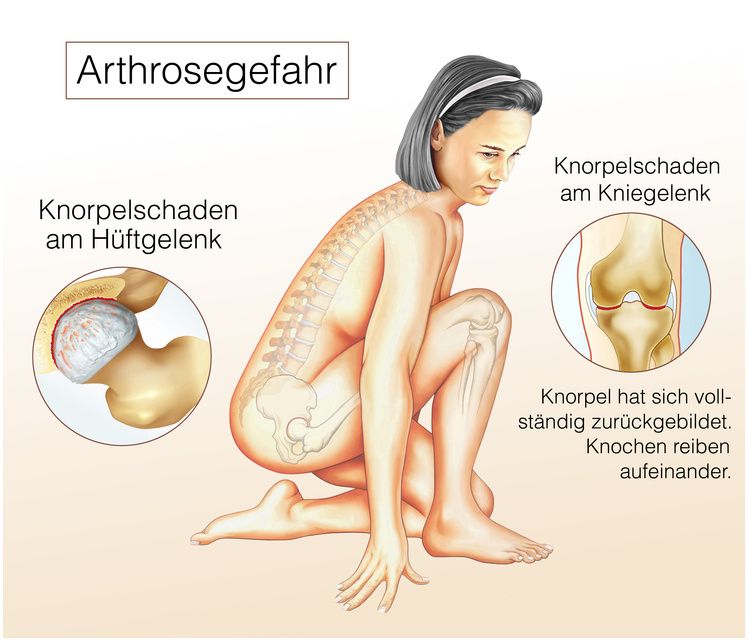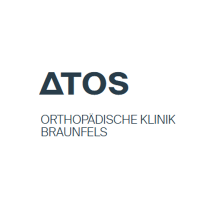In healthy people, the cartilage ensures that there is only indirect friction between the femoral head and the femur (thigh bone). Various underlying conditions can cause progressive wear of the articular cartilage in the hip joint. This phenomenon is called hip osteoarthritis or coxarthrosis (ICD code: M16).
In contrast to dormant hip osteoarthritis, signs of inflammation are present in activated hip osteoarthritis. Minute portions of cartilage tissue are then shed into the joint fluid, triggering inflammation.
The video shows joint wear caused by cartilage damage:
Hip osteoarthritis goes undetected for years and usually does not appear until older adulthood. X-rays and ultrasound examinations are used as diagnostic instruments.
Hip osteoarthritis always involves wear and tear of the joint cartilage. Over time, the cartilage becomes thinner and thinner, tears, and becomes rough. Initially, only small areas are affected by the damage and the patient does not exhibit any symptoms.
As the cartilage breaks down, the pressure on the underlying bones increases more and more. So-called subchondral scleroses develop on the bone. These are ossifications of the hip joint to compensate for the increased pressure and abrasion.
To compensate for the pressure, the joint surface enlarges and forms osteophytes, which make the hip joint more immobile. This process progresses more and more until the cartilage layer is completely worn away and the bones lie on the opposite bones without protection.

Osteoarthritis is a wear and tear disease that affects the cartilage of the joints © Henrie | AdobeStock
The causes of coxarthrosis can basically be divided into two groups.
Primary cause
Especially in patients over the age of 50, there is often no exact cause of the osteoarthritis. It is merely a hereditary weakness of the body and arises due to age-related degradation processes.
Secondary causes
Secondary causes include
Hip osteoarthritis is a chronic disease that usually develops over several years.
Significant signs of the disease are
- Increasing pain in the hip joint,
- Increasingly restricted movement, and
- Muscle tension.
In the case of activated hip osteoarthritis, which can occur in phases during the disease’s progression, the following other symptoms often occur
- Swelling,
- Redness, and
- Overheating.
The following symptoms characterize advanced coxarthrosis:
- Start-up pain: The patient feels pain at the onset of movement, especially after prolonged periods of rest.
- Joint pain that occurs with exertion
- Resting pain: The patient feels pain when lying or sitting.
- Gait abnormalities: After prolonged strain, a slight buckling of the side affected by the osteoarthritis is evident.
- Restricted movement: It is more difficult to bend, rotate, and stretch the thigh. The patient feels pain when spreading the thigh.
Physical exam for diagnosing coxarthrosis
The examination starts with a physical exam, which focuses on the
- Gait,
- Posture,
- Muscle weaknesses,
- Relieving posture, and
- possible deformities.
In advanced osteoarthritis of the hip joint, the internal rotation of the leg as well as deep bending (when sitting) is no longer possible.
Imaging techniques for diagnosing hip osteoarthritis
In an X-ray image, the narrowing of the joint cavity between the hip and femurs and the associated loss of cartilage is clearly visible. The narrower the joint cavity, the more advanced the hip osteoarthritis.
Osteophytes and subchondral sclerosis can also be identified on the X-ray.
The following are important for the digital planning of a hip prosthesis
- The femoral neck angle and
- The distance between the center of rotation of the femoral head and the femur.
In some cases, special examinations such as
are performed.
The progression of coxarthrosis is variable and depends on many different individual factors.
There are various treatment options. They range from conservative measures to the use of an artificial hip joint.
Conservative treatment
In the early stages of hip osteoarthritis, patients can be helped by special measures such as
Movement sequences that relieve the joints,
- Massages,
- Physiotherapy,
- orthopedic shoes, etc.,
which contribute significantly to slowing down the progression of the disease.
If the disease is more advanced, medications to relieve pain and reduce inflammation help.
Preventive measures continue to be weight loss and movements with low stress on the hip joint.
The use of a hip prosthesis for hip osteoarthritis
In the final stages of hip osteoarthritis and when the quality of life is severely compromised, surgical methods should be considered. One conceivable option is the use of a hip prosthesis.





































